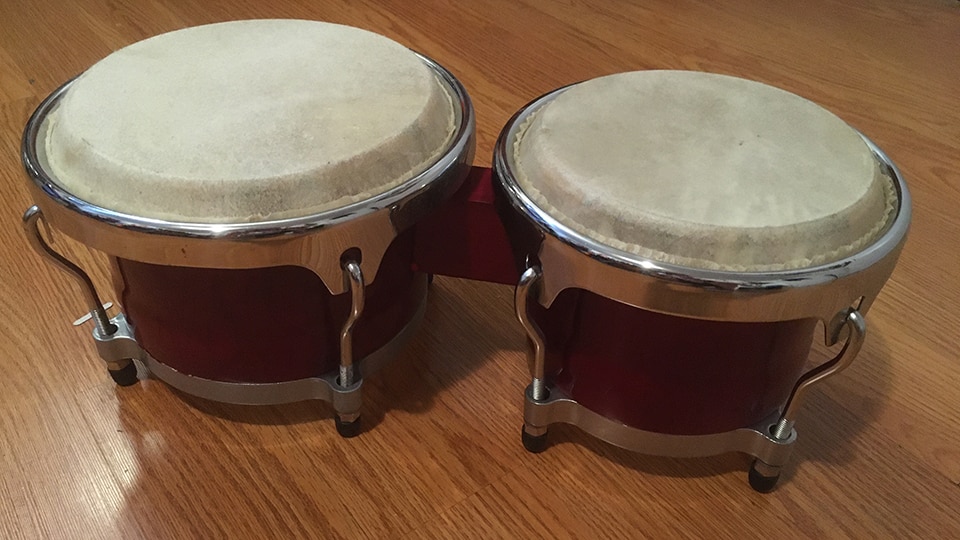Percussion is the backbone of all dance music; without it, there's nothing to dance to. Latin dance music favors hand drums – bongos, in particular. These small open-bottomed drums of African-Cuban origin come in pairs and even have names for each of its single drums: the larger drum is the hembra (meaning "female") and the smaller one is the macho ("male"). Bongos are the most popular hand drums in Latin music, along with congas, which are taller and narrower than bongos.
In bachata, bongos are joined by the güira, seen and heard above. It's a metallic instrument, usually made with a sheet of thin steel, with protruding nodules on its surface that are scraped with a stiff brush. Native to the Dominican Republic, this instrument is the primary timekeeper in a bachata band.
As we mentioned in the previous installment, bachata songs break down into three distinct polyrhythms that show up in different sections of a song: the derecho, majao, and mambo. Let's take a closer look at the different rhythms each percussion instrument plays in each section of Romeo Santos' "Héroe Favorito."
Derecho is the most basic rhythm of bachata; it mainly appears in a song's verses. Both the bongos and güira play all four upbeats and downbeats – in other words, all eight of a measure's eighth notes. The bongos accent beats one, three, and four, while the güira plays all four upbeats and downbeats with equal emphasis. Listen to the first verse at the 0:18 mark in "Héroe Favorito" and you'll notice the highest-pitched bongo hits are on beats one and three, with the lowest-pitched hit on beat four. Every now and then, the bongo drummer will highlight beat four with a drum roll, making the derecho really pop as it transitions smoothly into the next section.
"Héroe Favorito" moves into the majao rhythm in the first chorus section at 0:47. Here, the bongos and güira drop all of the upbeats, and play just the downbeats, The bongos now emphasize all four downbeats equally, with the lowest-pitched hit still on beat four, like it did in the derecho. The güira plays all four downbeats here with slightly longer scrapes. As the end of the chorus approaches at 1:13, the bongo and güira players liven things up with some complex rhythmic flourishes before transitioning back into the derecho.
The third type of polyrhythm, the mambo, tends to be the most exciting one because it's where all instruments are free to improvise, and it's often where the singer stops singing. It's no coincidence that "mambo" is also the name of a music genre and style of dance from Cuba, and that mambo rhythms appear in many other Latin music styles like salsa and merengue: it's the section where musicians and dancers alike get to freely express themselves. With the exception of the güira, which plays a strict pattern of "1, 2-and 3, 4-and 1," the rhythms aren't always easy to pin down: the mambo section is more of a high-energy feeling, rather than a defined rhythmic pattern. Check out the classic mambo pattern in the güira at 3:03 in "Héroe Favorito." You'll also notice this section follows up some incredible guitar playing; we'll talk about the role that guitars play in bachata in the next installment.
Leila Abdul-Rauf is a multi-instrumentalist and composer based in Oakland, CA. Leila is guitarist and vocalist for metal bands Vastum, Hammers of Misfortune, and ethereal post-punk band Terebellum. She also composes and produces ambient music under her own name, with electronic trio Ionophore, and with synth-folk duo Fyrhtu. She has toured internationally and is a private guitar and voice teacher in her spare time.
Bongo photo by Dan Amrich. Used with permission.
Güira video by LP Percussion.
There's much more to explore with Rocksmith+. Click here and take the next step on your musical journey.



